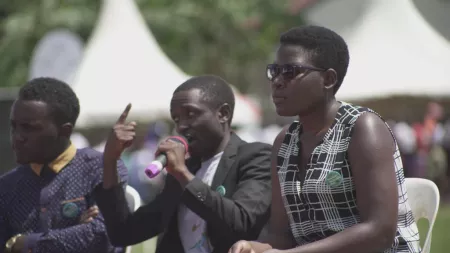“I remember when this place had huge trees…it was a source of pride” says Kelle. After years in a camp fleeing conflict, Kelle and others returned to find no houses, and had to cut down the trees to survive. IT devastated the environment. Now, Kelle is training others to use climate smart farming, so they can recover from the shocks of climate change and conflict. “Now we are in a position of having some money at home … and sending our kids to school.”
Juliet Grace Luwedde is a young climate activist in Uganda who works with the Africa Youth Initiative for Climate change, and the Media Challenge Initiative—focusing on climate change. She uses her voice and the media to push for change in the world.
Together, these women represent different ways to lead. They're both instrumental dealing with climate change in their communities, partnering with CARE and others to build a better future.
Partners for Resilience ran in Uganda from 2016-2021 with $1.1 million from the Dutch Ministry of Foreign Affairs. It reached 7,758 people directly and 22,936 indirectly.
What changed?
- Civil Society is more influential. The recommendations Civil Society Organizations make are getting picked up and implemented in national policies, and policies are passing. A wetlands bill that had stalled and a climate change bill that had stalled both passed with advocacy from these groups. Partner organizations were also able to raise more money to support these priorities.
- Local voices connect to national issues. The project is getting people to talk about climate change, even for people “outside the political bubble” and media, civil society, and community groups are collaborating to promote action.
- The government is accountable for measuring progress. The government adopted standard national climate change indicators so they can implement and track their climate change policies.
- The government is prioritizing climate change. The Prime Minister fast-tracked the National Disaster Preparedness and Management Policy, and climate change is higher on the parliamentary agenda.
- Policies are making a difference locally. Local governments are actively rolling out changes around the new wetlands policies.
- The government is more prepared to act. The standing climate change committee in the Ugandan parliament is more prepared to be active as a champion to address climate change.
How did it happen?
- Get more inclusive. The project broadened the list of local partners (see below) to connect a range of groups with different expertise—from evidence to national policy processes, to understanding local advocacy issues. The team also deliberately worked to ensure that people from marginalized groups had a say in design and implementation.
- Stay on the lookout for the opportune moment. The 2016 climate change law became a good framework and mobilizing moment to bring local groups together and support civil society to contribute to policy. These opportunities weren’t just national, but also local.
- Align to common goals. Using the frame of the Sustainable Development Goals (SDGs) and global priorities like the Ramsar agreement helped focus and build alignment and agreement across different actors.
- Tap into government ambitions. The partners added some activities to attract investments in line with the Government of Uganda’s ambition to be a middle income country by 2040.
- Pay for the costs of participation. The project paid for national government members and members of the Ugandan media to go to COP in 2018 and 2019.
- Learn and be flexible. The partners had regular reflection events to see if they were on track, identify changes in the local context, and adapt project goals and activities as needed.
- Let go of control. Over time, the project got more flexible about budgeting and having more budget control directly in the hands of local partners. There is still room to improve, but being adaptable and putting money more in line with local control and priorities is an important step.
- Support community plans. Communities applied CARE’s Climate Vulnerability and Capacity Analysis (CVCA) methodology to analyze their vulnerability and their capacity to reduce disaster risk, mostly caused by environmental degradation and climate change (see CVCA report here).
- Support savings. The project worked with 6,549 VLSA members to use local weather information to plan farming, loans, and local insurance. The government has also adopted the climate smart agriculture methods VSLA members were using.
Want to learn more?
Check out the evaluation and the project brief. Watch Kelle’s story here.
Special Thanks
The partners for Partners for Resilience included the Netherlands Red Cross, Cordaid, Wetlands International, the Red Cross Red Crescent Climate Center, ECO, Parliamentary Forum on Climate Change, Participatory Ecological Land Use Management (PELUM) Uganda, SOCADIDO, Uganda Red Cross Societyu, Facilitation for Peace and Development (FAPAD), and the Environmental Management for Livelihood Improvement (EMLI). CARE led the components on capacity strengthening and advocacy.
